Презентация Microsoft Office PowerPoint.pptx
- Количество слайдов: 35
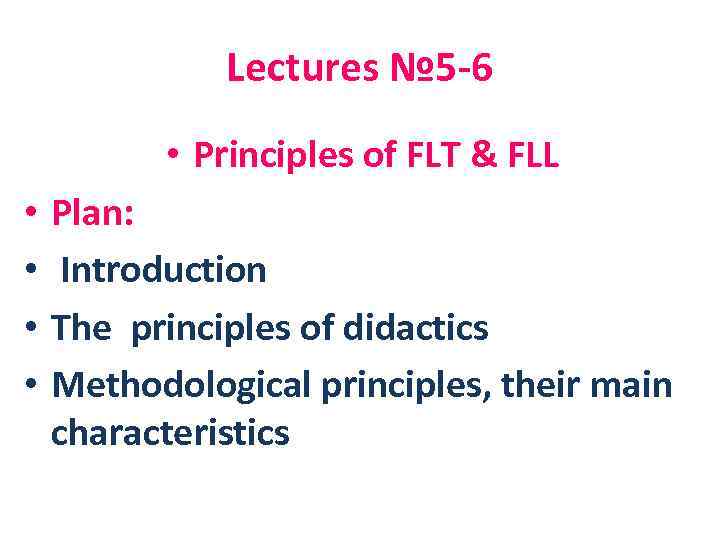 Lectures № 5 -6 • Principles of FLT & FLL • • Plan: Introduction The principles of didactics Methodological principles, their main characteristics
Lectures № 5 -6 • Principles of FLT & FLL • • Plan: Introduction The principles of didactics Methodological principles, their main characteristics
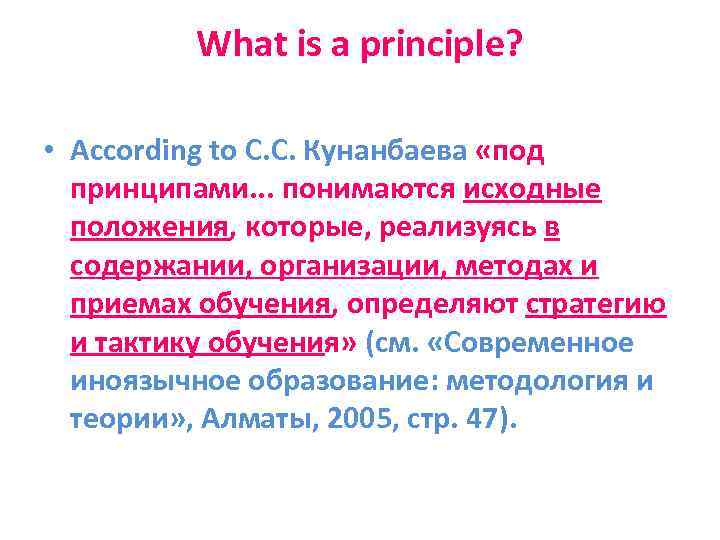 What is a principle? • According to C. C. Кунанбаева «под принципами. . . понимаются исходные положения, которые, реализуясь в содержании, организации, методах и приемах обучения, определяют стратегию и тактику обучения» (см. «Современное иноязычное образование: методология и теории» , Алматы, 2005, стр. 47).
What is a principle? • According to C. C. Кунанбаева «под принципами. . . понимаются исходные положения, которые, реализуясь в содержании, организации, методах и приемах обучения, определяют стратегию и тактику обучения» (см. «Современное иноязычное образование: методология и теории» , Алматы, 2005, стр. 47).
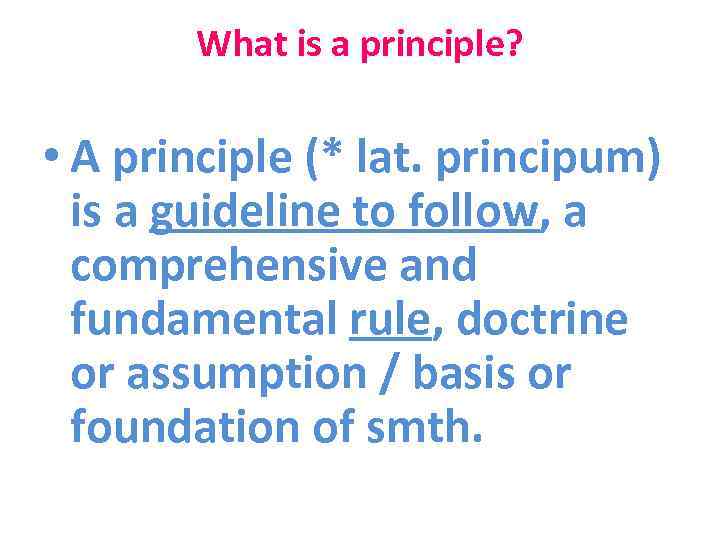 What is a principle? • A principle (* lat. principum) is a guideline to follow, a comprehensive and fundamental rule, doctrine or assumption / basis or foundation of smth.
What is a principle? • A principle (* lat. principum) is a guideline to follow, a comprehensive and fundamental rule, doctrine or assumption / basis or foundation of smth.
 Principles of didactics Principles of FLT Methodology • General principles • 1. Communicativeness • 2. Domineering role of exercises • 3. Integration and differentiation • 4. Native language basis Specific principles 1. Pattern Practice 2. Oral approach 3. Intensive study at the Primary stage • 4. Approximation • •
Principles of didactics Principles of FLT Methodology • General principles • 1. Communicativeness • 2. Domineering role of exercises • 3. Integration and differentiation • 4. Native language basis Specific principles 1. Pattern Practice 2. Oral approach 3. Intensive study at the Primary stage • 4. Approximation • •
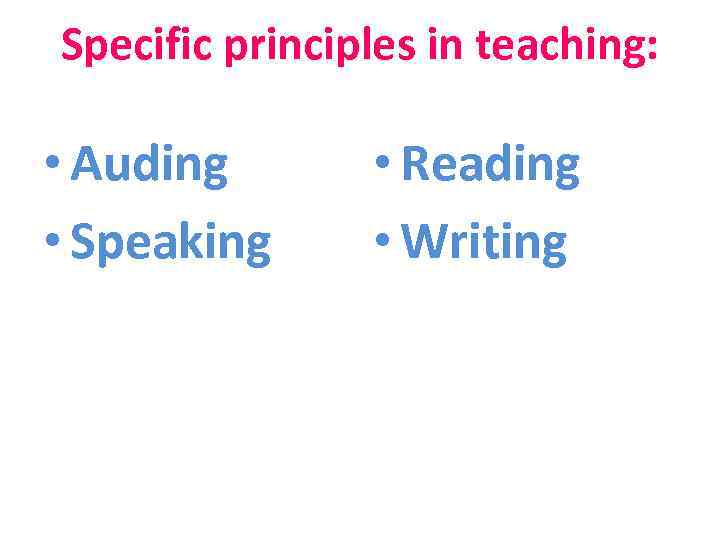 Specific principles in teaching: • Auding • Speaking • Reading • Writing
Specific principles in teaching: • Auding • Speaking • Reading • Writing
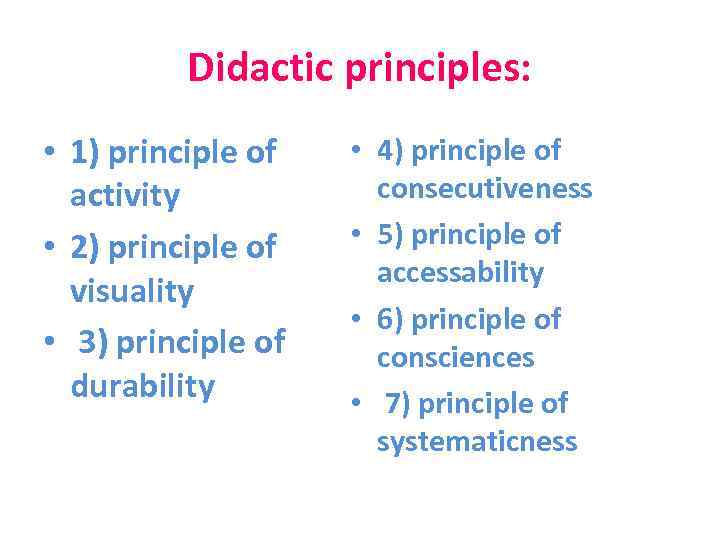 Didactic principles: • 1) principle of activity • 2) principle of visuality • 3) principle of durability • 4) principle of consecutiveness • 5) principle of accessability • 6) principle of consciences • 7) principle of systematicness
Didactic principles: • 1) principle of activity • 2) principle of visuality • 3) principle of durability • 4) principle of consecutiveness • 5) principle of accessability • 6) principle of consciences • 7) principle of systematicness
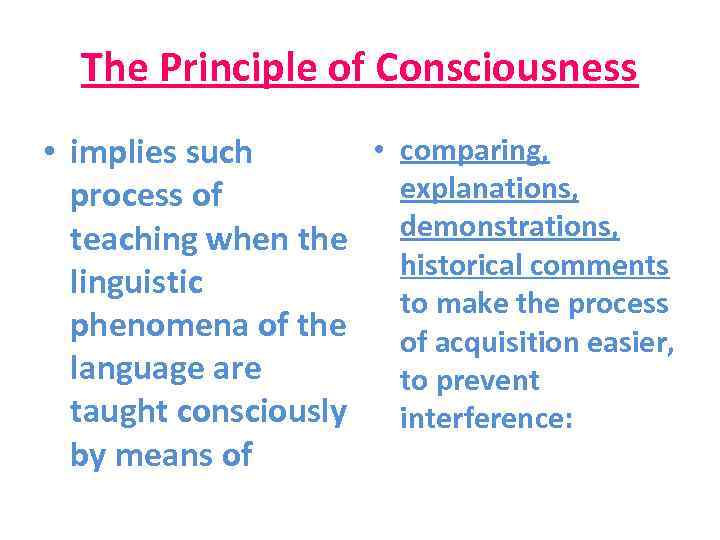 The Principle of Consciousness • comparing, • implies such explanations, process of teaching when the demonstrations, historical comments linguistic to make the process phenomena of the of acquisition easier, language are to prevent taught consciously interference: by means of
The Principle of Consciousness • comparing, • implies such explanations, process of teaching when the demonstrations, historical comments linguistic to make the process phenomena of the of acquisition easier, language are to prevent taught consciously interference: by means of
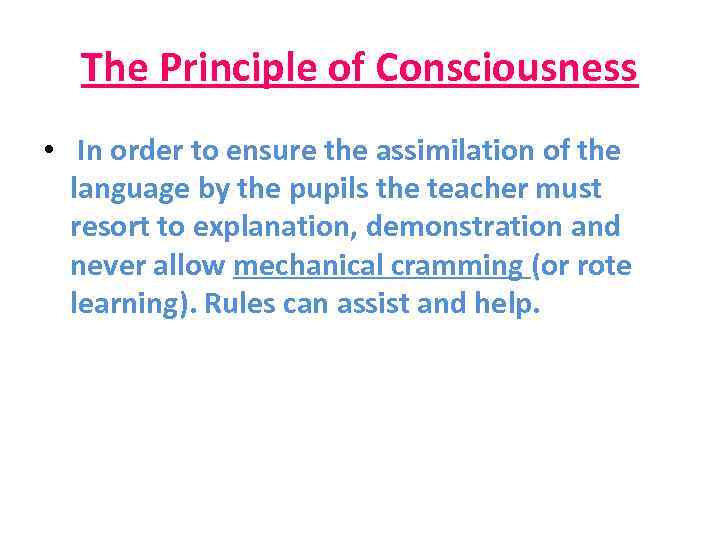 The Principle of Consciousness • In order to ensure the assimilation of the language by the pupils the teacher must resort to explanation, demonstration and never allow mechanical cramming (or rote learning). Rules can assist and help.
The Principle of Consciousness • In order to ensure the assimilation of the language by the pupils the teacher must resort to explanation, demonstration and never allow mechanical cramming (or rote learning). Rules can assist and help.
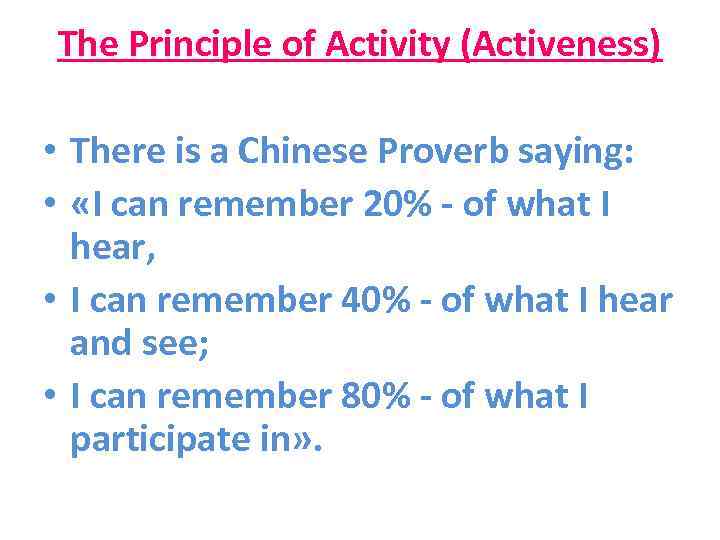 The Principle of Activity (Activeness) • There is a Chinese Proverb saying: • «I can remember 20% - of what I hear, • I can remember 40% - of what I hear and see; • I can remember 80% - of what I participate in» .
The Principle of Activity (Activeness) • There is a Chinese Proverb saying: • «I can remember 20% - of what I hear, • I can remember 40% - of what I hear and see; • I can remember 80% - of what I participate in» .
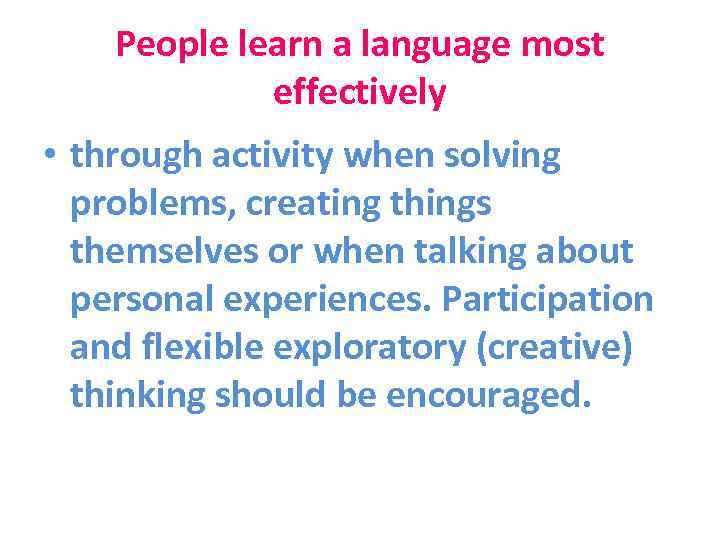 People learn a language most effectively • through activity when solving problems, creating things themselves or when talking about personal experiences. Participation and flexible exploratory (creative) thinking should be encouraged.
People learn a language most effectively • through activity when solving problems, creating things themselves or when talking about personal experiences. Participation and flexible exploratory (creative) thinking should be encouraged.
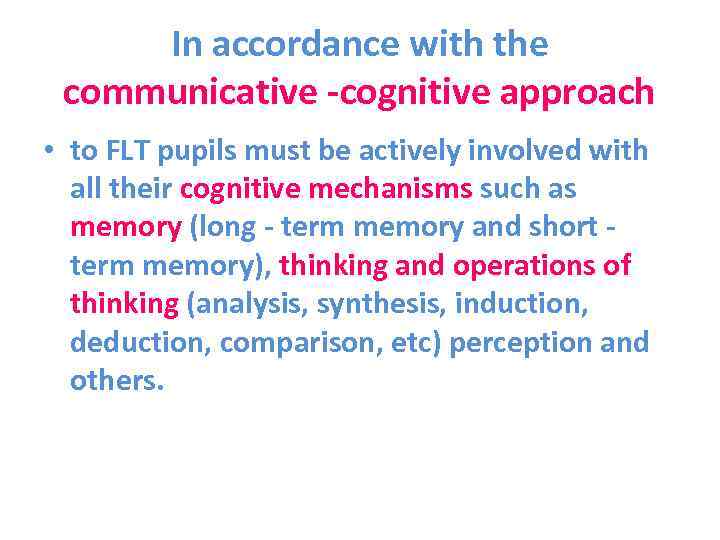 In accordance with the communicative -cognitive approach • to FLT pupils must be actively involved with all their cognitive mechanisms such as memory (long - term memory and short - term memory), thinking and operations of thinking (analysis, synthesis, induction, deduction, comparison, etc) perception and others.
In accordance with the communicative -cognitive approach • to FLT pupils must be actively involved with all their cognitive mechanisms such as memory (long - term memory and short - term memory), thinking and operations of thinking (analysis, synthesis, induction, deduction, comparison, etc) perception and others.
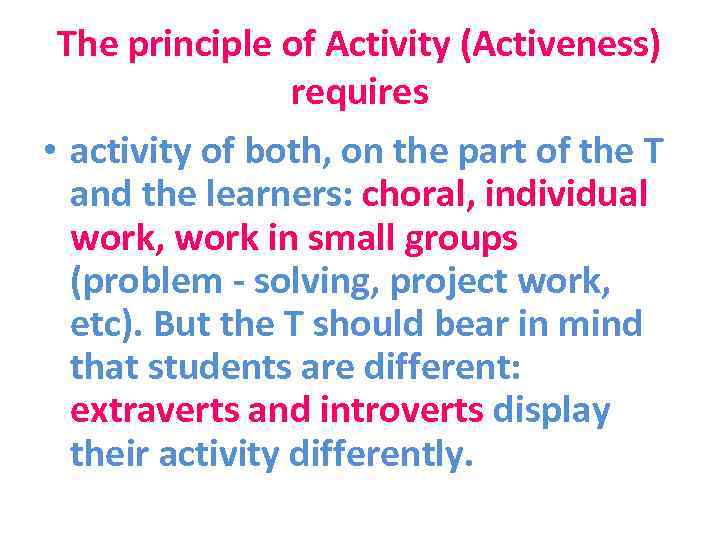 The principle of Activity (Activeness) requires • activity of both, on the part of the T and the learners: choral, individual work, work in small groups (problem - solving, project work, etc). But the T should bear in mind that students are different: extraverts and introverts display their activity differently.
The principle of Activity (Activeness) requires • activity of both, on the part of the T and the learners: choral, individual work, work in small groups (problem - solving, project work, etc). But the T should bear in mind that students are different: extraverts and introverts display their activity differently.
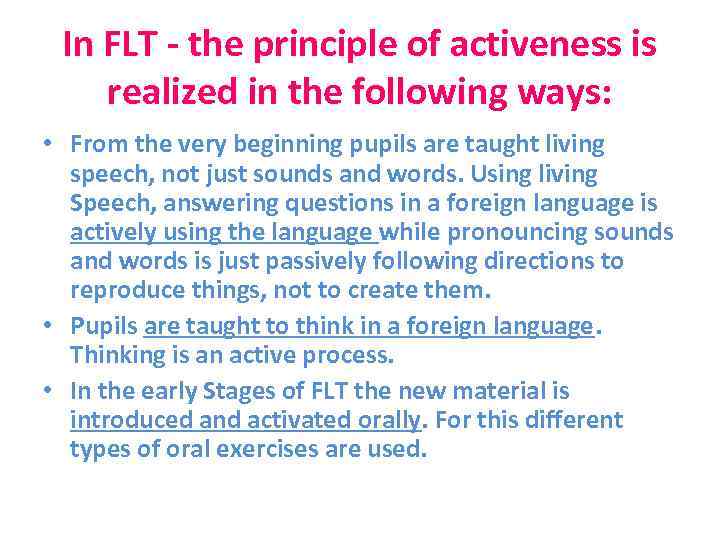 In FLT - the principle of activeness is realized in the following ways: • From the very beginning pupils are taught living speech, not just sounds and words. Using living Speech, answering questions in a foreign language is actively using the language while pronouncing sounds and words is just passively following directions to reproduce things, not to create them. • Pupils are taught to think in a foreign language. Thinking is an active process. • In the early Stages of FLT the new material is introduced and activated orally. For this different types of oral exercises are used.
In FLT - the principle of activeness is realized in the following ways: • From the very beginning pupils are taught living speech, not just sounds and words. Using living Speech, answering questions in a foreign language is actively using the language while pronouncing sounds and words is just passively following directions to reproduce things, not to create them. • Pupils are taught to think in a foreign language. Thinking is an active process. • In the early Stages of FLT the new material is introduced and activated orally. For this different types of oral exercises are used.
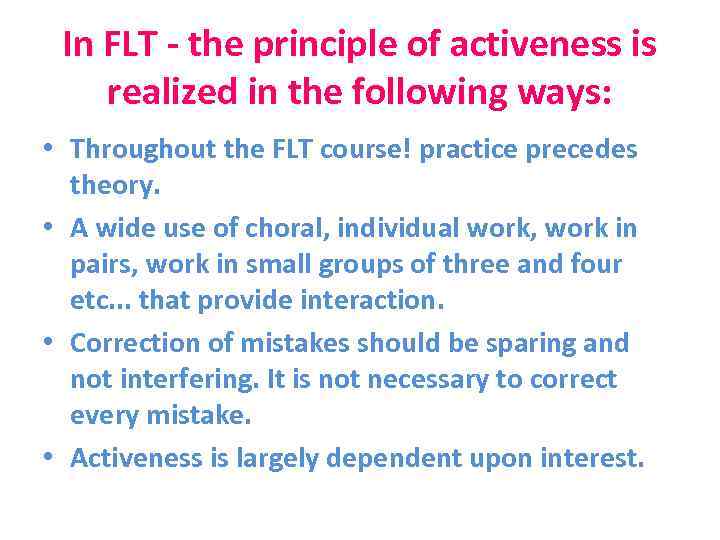 In FLT - the principle of activeness is realized in the following ways: • Throughout the FLT course! practice precedes theory. • A wide use of choral, individual work, work in pairs, work in small groups of three and four etc. . . that provide interaction. • Correction of mistakes should be sparing and not interfering. It is not necessary to correct every mistake. • Activeness is largely dependent upon interest.
In FLT - the principle of activeness is realized in the following ways: • Throughout the FLT course! practice precedes theory. • A wide use of choral, individual work, work in pairs, work in small groups of three and four etc. . . that provide interaction. • Correction of mistakes should be sparing and not interfering. It is not necessary to correct every mistake. • Activeness is largely dependent upon interest.
 A Сhinese legend says: • "Give a man a fish and he will eat it all day long; show him how to fish and he will eat all the year round".
A Сhinese legend says: • "Give a man a fish and he will eat it all day long; show him how to fish and he will eat all the year round".
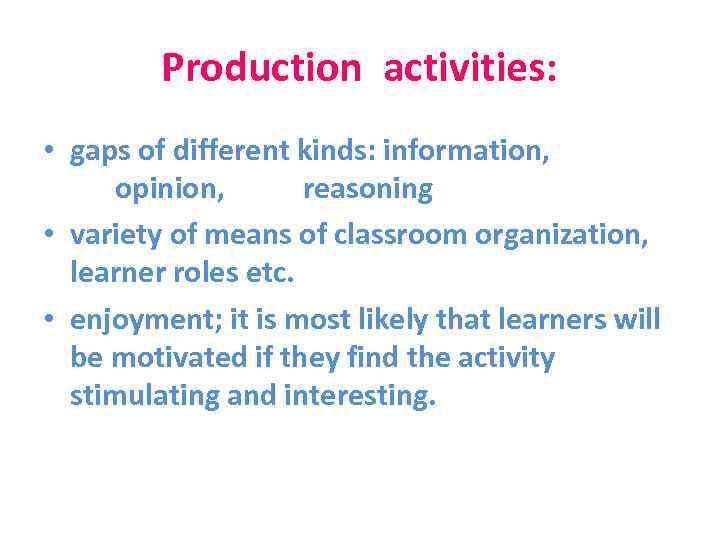 Production activities: • gaps of different kinds: information, opinion, reasoning • variety of means of classroom organization, learner roles etc. • enjoyment; it is most likely that learners will be motivated if they find the activity stimulating and interesting.
Production activities: • gaps of different kinds: information, opinion, reasoning • variety of means of classroom organization, learner roles etc. • enjoyment; it is most likely that learners will be motivated if they find the activity stimulating and interesting.
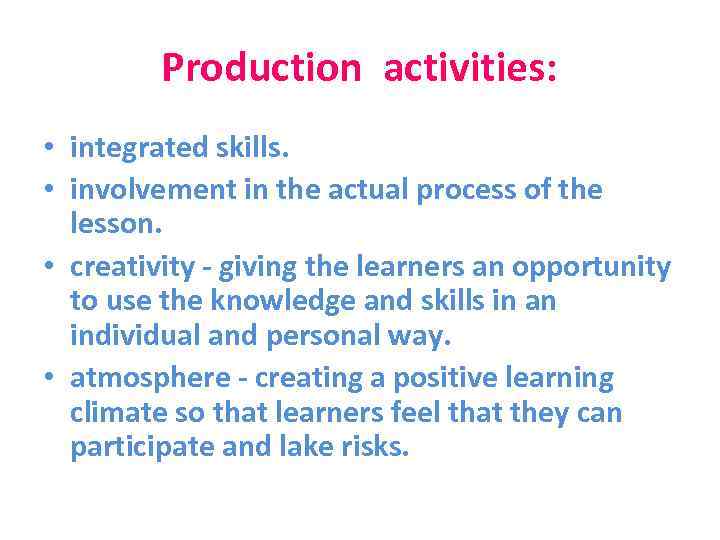 Production activities: • integrated skills. • involvement in the actual process of the lesson. • creativity - giving the learners an opportunity to use the knowledge and skills in an individual and personal way. • atmosphere - creating a positive learning climate so that learners feel that they can participate and lake risks.
Production activities: • integrated skills. • involvement in the actual process of the lesson. • creativity - giving the learners an opportunity to use the knowledge and skills in an individual and personal way. • atmosphere - creating a positive learning climate so that learners feel that they can participate and lake risks.
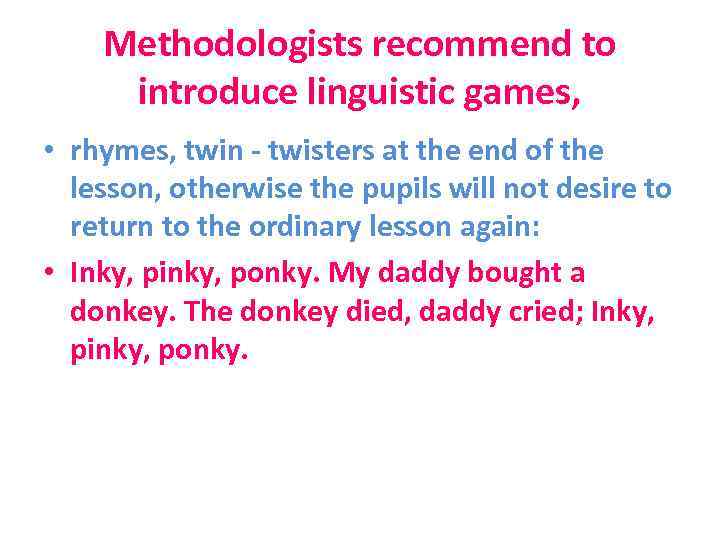 Methodologists recommend to introduce linguistic games, • rhymes, twin - twisters at the end of the lesson, otherwise the pupils will not desire to return to the ordinary lesson again: • Inky, pinky, ponky. My daddy bought a donkey. The donkey died, daddy cried; Inky, pinky, ponky.
Methodologists recommend to introduce linguistic games, • rhymes, twin - twisters at the end of the lesson, otherwise the pupils will not desire to return to the ordinary lesson again: • Inky, pinky, ponky. My daddy bought a donkey. The donkey died, daddy cried; Inky, pinky, ponky.
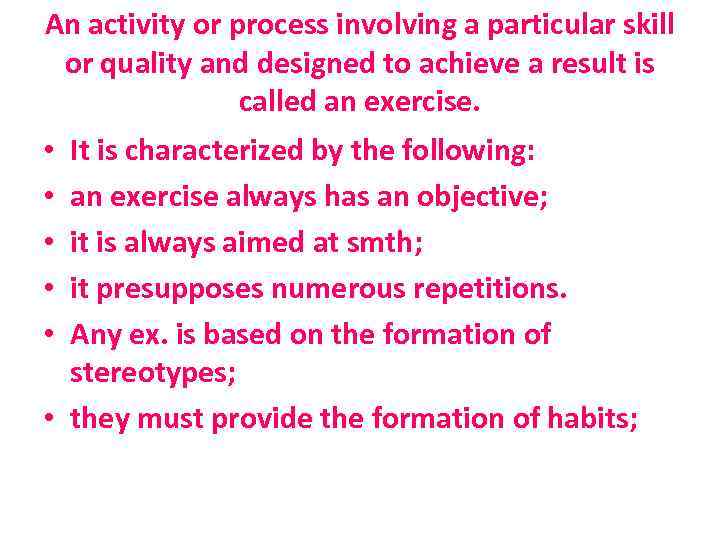 An activity or process involving a particular skill or quality and designed to achieve a result is called an exercise. It is characterized by the following: an exercise always has an objective; it is always aimed at smth; it presupposes numerous repetitions. Any ex. is based on the formation of stereotypes; • they must provide the formation of habits; • • •
An activity or process involving a particular skill or quality and designed to achieve a result is called an exercise. It is characterized by the following: an exercise always has an objective; it is always aimed at smth; it presupposes numerous repetitions. Any ex. is based on the formation of stereotypes; • they must provide the formation of habits; • • •
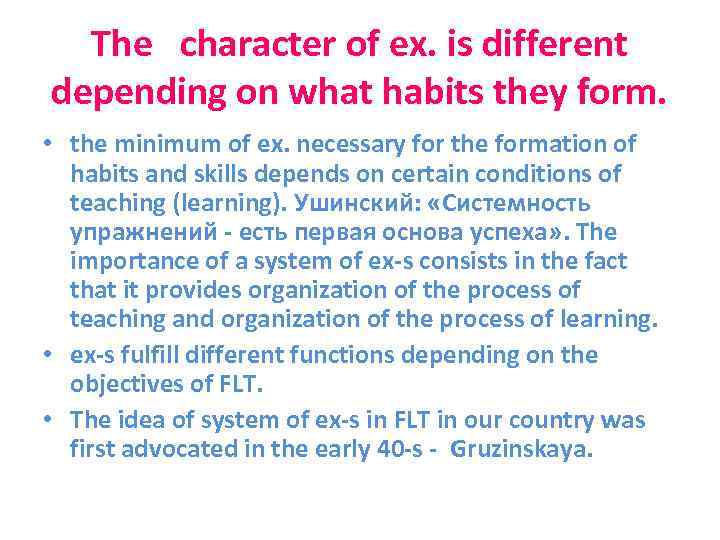 The character of ex. is different depending on what habits they form. • the minimum of ex. necessary for the formation of habits and skills depends on certain conditions of teaching (learning). Ушинский: «Системность упражнений - есть первая основа успеха» . The importance of a system of ex-s consists in the fact that it provides organization of the process of teaching and organization of the process of learning. • ex-s fulfill different functions depending on the objectives of FLT. • The idea of system of ex-s in FLT in our country was first advocated in the early 40 -s - Gruzinskaya.
The character of ex. is different depending on what habits they form. • the minimum of ex. necessary for the formation of habits and skills depends on certain conditions of teaching (learning). Ушинский: «Системность упражнений - есть первая основа успеха» . The importance of a system of ex-s consists in the fact that it provides organization of the process of teaching and organization of the process of learning. • ex-s fulfill different functions depending on the objectives of FLT. • The idea of system of ex-s in FLT in our country was first advocated in the early 40 -s - Gruzinskaya.
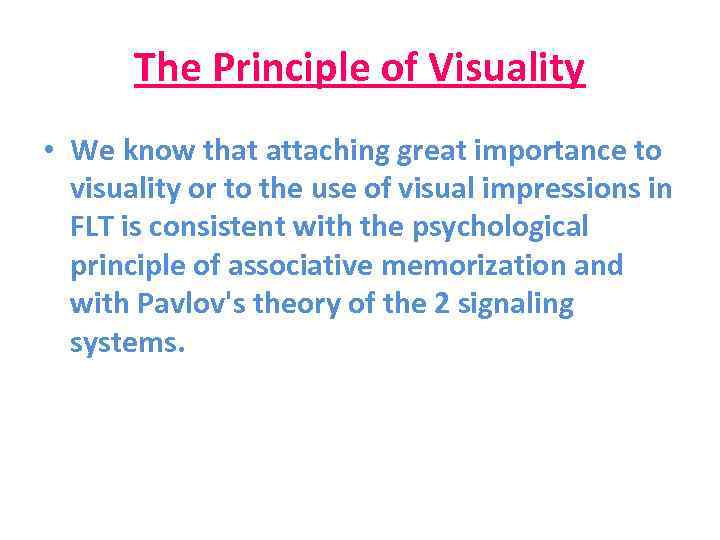 The Principle of Visuality • We know that attaching great importance to visuality or to the use of visual impressions in FLT is consistent with the psychological principle of associative memorization and with Pavlov's theory of the 2 signaling systems.
The Principle of Visuality • We know that attaching great importance to visuality or to the use of visual impressions in FLT is consistent with the psychological principle of associative memorization and with Pavlov's theory of the 2 signaling systems.
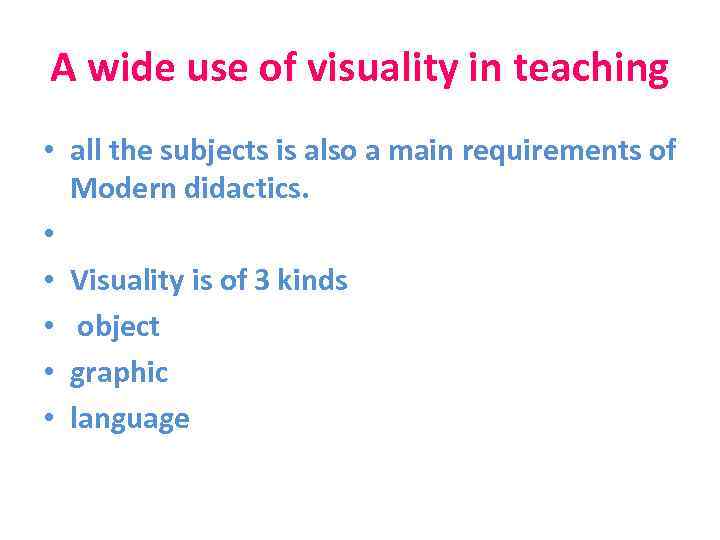 A wide use of visuality in teaching • all the subjects is also a main requirements of Modern didactics. • • Visuality is of 3 kinds • object • graphic • language
A wide use of visuality in teaching • all the subjects is also a main requirements of Modern didactics. • • Visuality is of 3 kinds • object • graphic • language
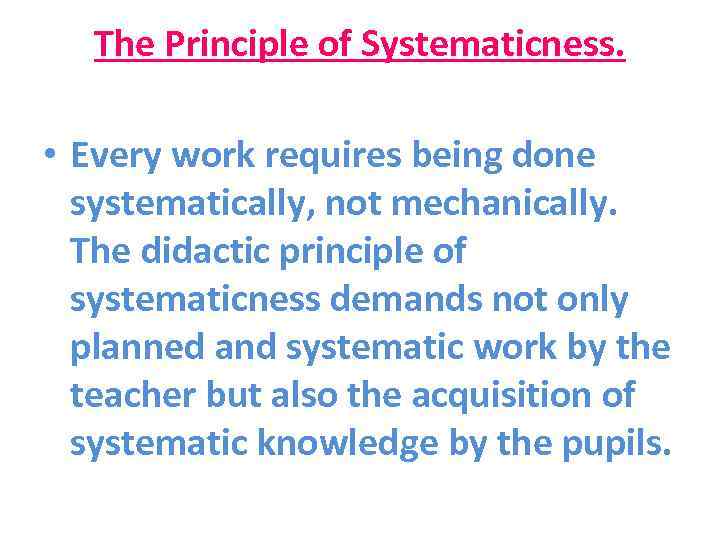 The Principle of Systematicness. • Every work requires being done systematically, not mechanically. The didactic principle of systematicness demands not only planned and systematic work by the teacher but also the acquisition of systematic knowledge by the pupils.
The Principle of Systematicness. • Every work requires being done systematically, not mechanically. The didactic principle of systematicness demands not only planned and systematic work by the teacher but also the acquisition of systematic knowledge by the pupils.
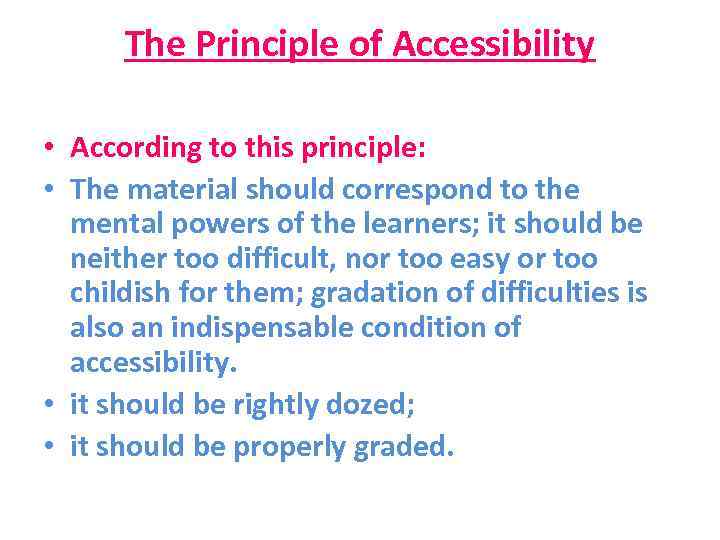 The Principle of Accessibility • According to this principle: • The material should correspond to the mental powers of the learners; it should be neither too difficult, nor too easy or too childish for them; gradation of difficulties is also an indispensable condition of accessibility. • it should be rightly dozed; • it should be properly graded.
The Principle of Accessibility • According to this principle: • The material should correspond to the mental powers of the learners; it should be neither too difficult, nor too easy or too childish for them; gradation of difficulties is also an indispensable condition of accessibility. • it should be rightly dozed; • it should be properly graded.
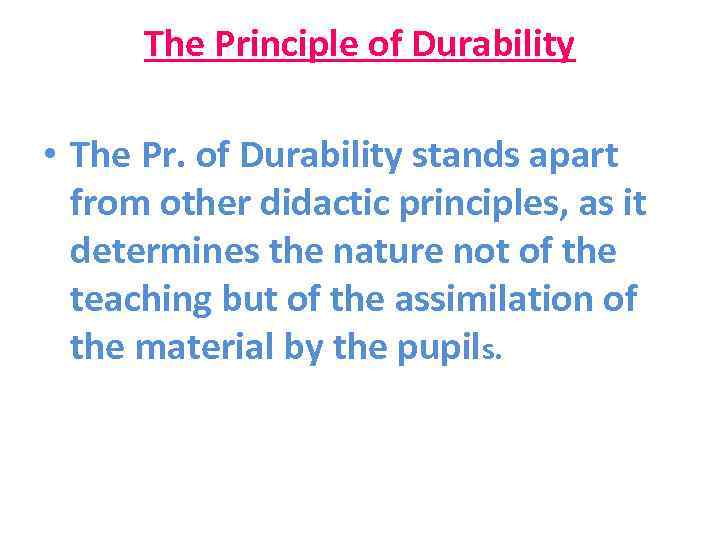 The Principle of Durability • The Pr. of Durability stands apart from other didactic principles, as it determines the nature not of the teaching but of the assimilation of the material by the pupils.
The Principle of Durability • The Pr. of Durability stands apart from other didactic principles, as it determines the nature not of the teaching but of the assimilation of the material by the pupils.
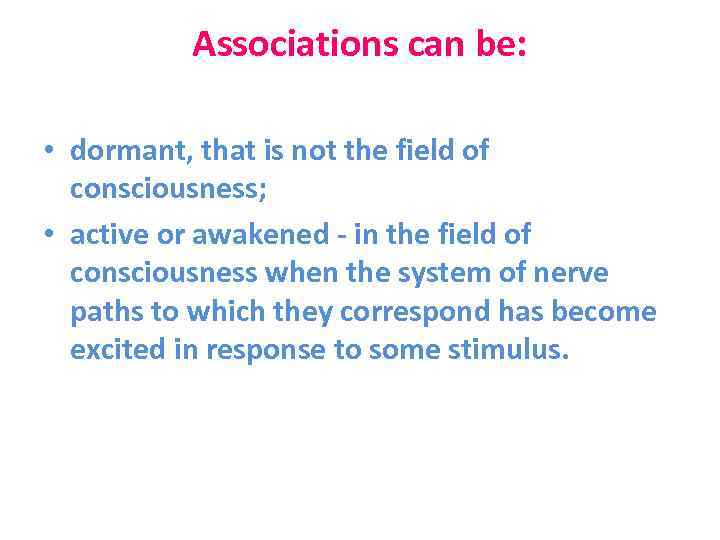 Associations can be: • dormant, that is not the field of consciousness; • active or awakened - in the field of consciousness when the system of nerve paths to which they correspond has become excited in response to some stimulus.
Associations can be: • dormant, that is not the field of consciousness; • active or awakened - in the field of consciousness when the system of nerve paths to which they correspond has become excited in response to some stimulus.
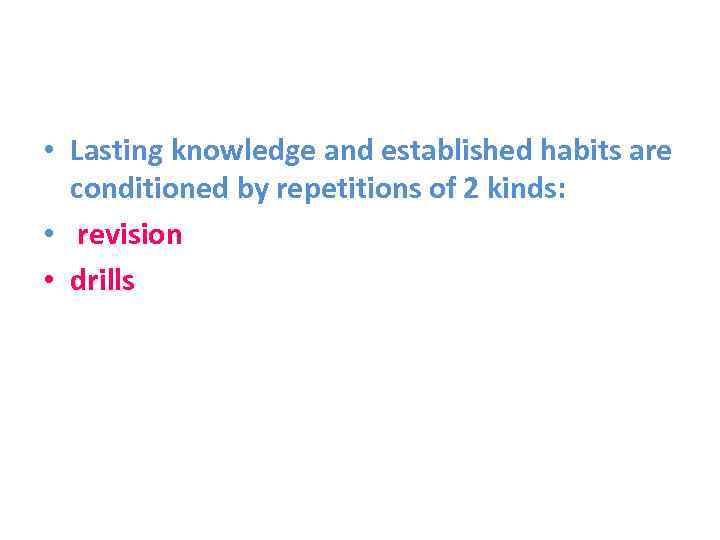 • Lasting knowledge and established habits are conditioned by repetitions of 2 kinds: • revision • drills
• Lasting knowledge and established habits are conditioned by repetitions of 2 kinds: • revision • drills
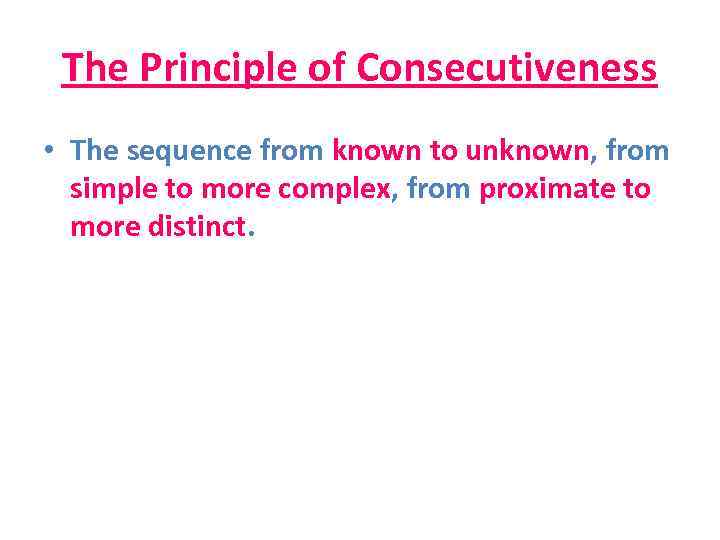 The Principle of Consecutiveness • The sequence from known to unknown, from simple to more complex, from proximate to more distinct.
The Principle of Consecutiveness • The sequence from known to unknown, from simple to more complex, from proximate to more distinct.
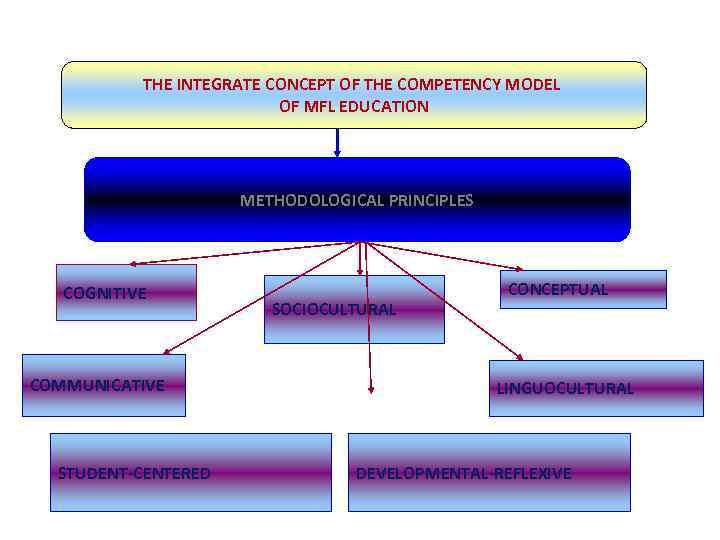 THE INTEGRATE CONCEPT OF THE COMPETENCY MODEL OF MFL EDUCATION METHODOLOGICAL PRINCIPLES COGNITIVE COMMUNICATIVE STUDENT-CENTERED SOCIOCULTURAL CONCEPTUAL LINGUOCULTURAL DEVELOPMENTAL-REFLEXIVE
THE INTEGRATE CONCEPT OF THE COMPETENCY MODEL OF MFL EDUCATION METHODOLOGICAL PRINCIPLES COGNITIVE COMMUNICATIVE STUDENT-CENTERED SOCIOCULTURAL CONCEPTUAL LINGUOCULTURAL DEVELOPMENTAL-REFLEXIVE
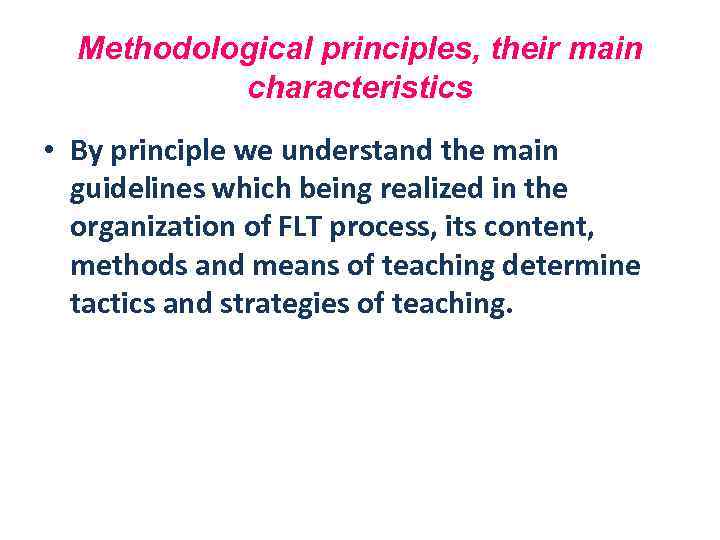 Methodological principles, their main characteristics • By principle we understand the main guidelines which being realized in the organization of FLT process, its content, methods and means of teaching determine tactics and strategies of teaching.
Methodological principles, their main characteristics • By principle we understand the main guidelines which being realized in the organization of FLT process, its content, methods and means of teaching determine tactics and strategies of teaching.
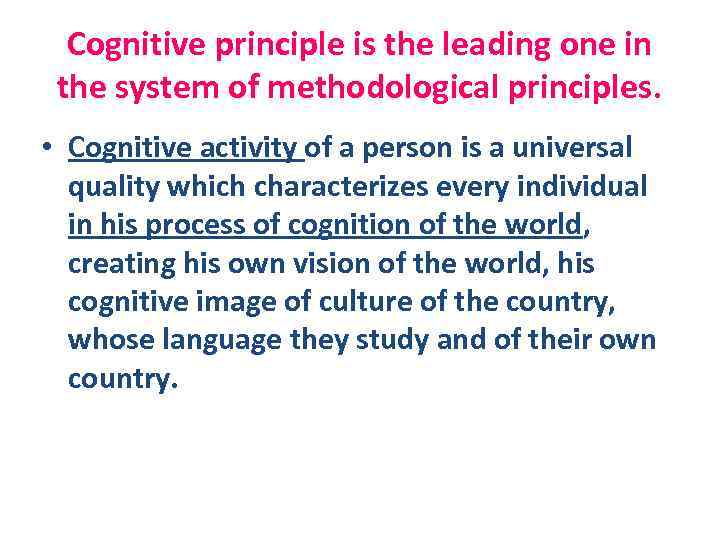 Cognitive principle is the leading one in the system of methodological principles. • Cognitive activity of a person is a universal quality which characterizes every individual in his process of cognition of the world, creating his own vision of the world, his cognitive image of culture of the country, whose language they study and of their own country.
Cognitive principle is the leading one in the system of methodological principles. • Cognitive activity of a person is a universal quality which characterizes every individual in his process of cognition of the world, creating his own vision of the world, his cognitive image of culture of the country, whose language they study and of their own country.
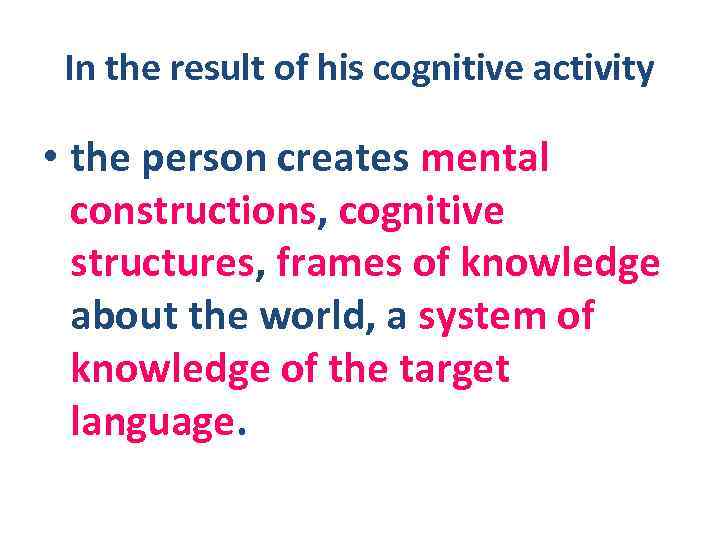 In the result of his cognitive activity • the person creates mental constructions, cognitive structures, frames of knowledge about the world, a system of knowledge of the target language.
In the result of his cognitive activity • the person creates mental constructions, cognitive structures, frames of knowledge about the world, a system of knowledge of the target language.
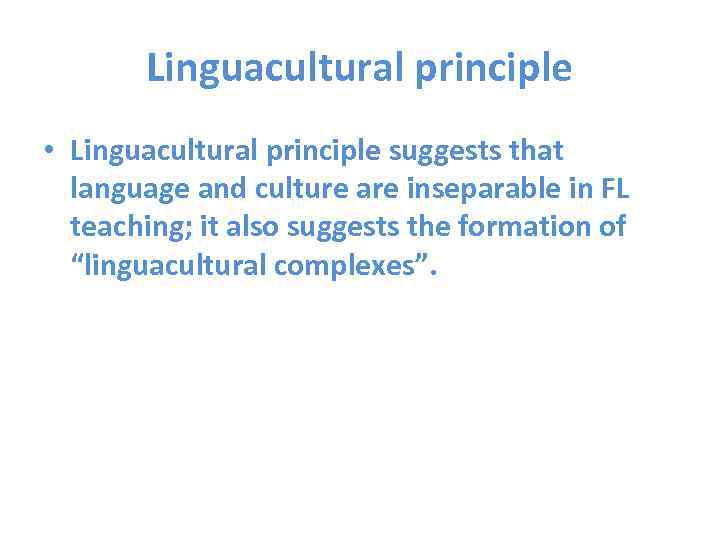 Linguacultural principle • Linguacultural principle suggests that language and culture are inseparable in FL teaching; it also suggests the formation of “linguacultural complexes”.
Linguacultural principle • Linguacultural principle suggests that language and culture are inseparable in FL teaching; it also suggests the formation of “linguacultural complexes”.
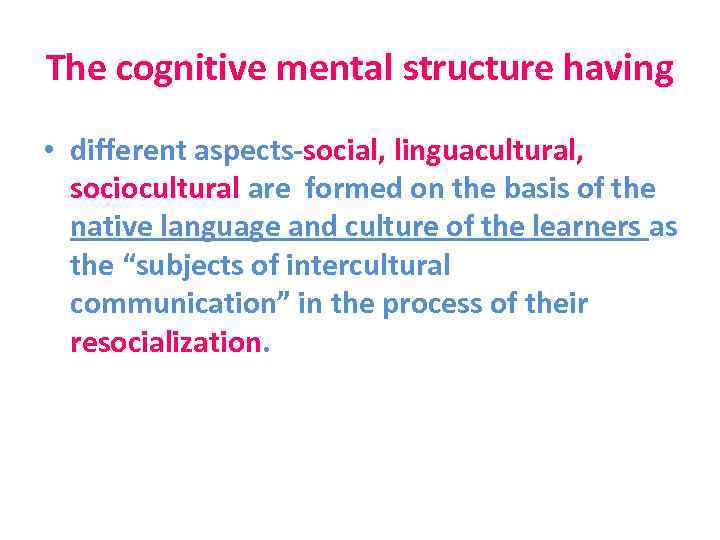 The cognitive mental structure having • different aspects-social, linguacultural, sociocultural are formed on the basis of the native language and culture of the learners as the “subjects of intercultural communication” in the process of their resocialization.
The cognitive mental structure having • different aspects-social, linguacultural, sociocultural are formed on the basis of the native language and culture of the learners as the “subjects of intercultural communication” in the process of their resocialization.
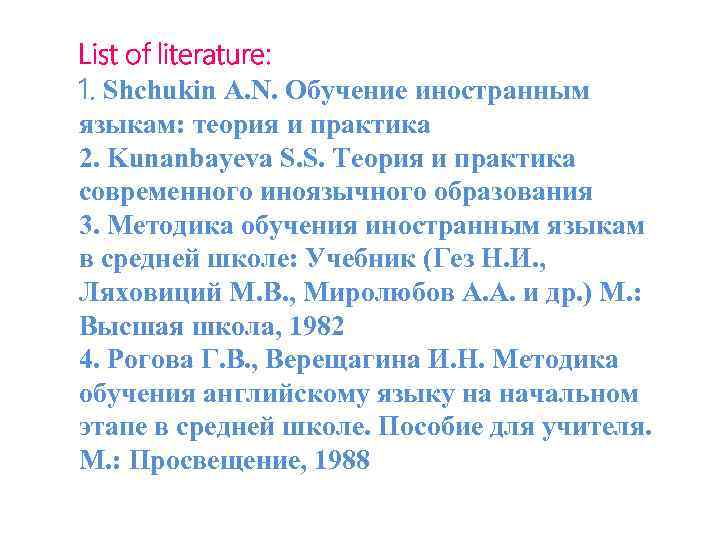 List of literature: 1. Shchukin A. N. Обучение иностранным языкам: теория и практика 2. Kunanbayeva S. S. Теория и практика современного иноязычного образования 3. Методика обучения иностранным языкам в средней школе: Учебник (Гез Н. И. , Ляховиций М. В. , Миролюбов А. А. и др. ) М. : Высшая школа, 1982 4. Рогова Г. В. , Верещагина И. Н. Методика обучения английскому языку на начальном этапе в средней школе. Пособие для учителя. М. : Просвещение, 1988
List of literature: 1. Shchukin A. N. Обучение иностранным языкам: теория и практика 2. Kunanbayeva S. S. Теория и практика современного иноязычного образования 3. Методика обучения иностранным языкам в средней школе: Учебник (Гез Н. И. , Ляховиций М. В. , Миролюбов А. А. и др. ) М. : Высшая школа, 1982 4. Рогова Г. В. , Верещагина И. Н. Методика обучения английскому языку на начальном этапе в средней школе. Пособие для учителя. М. : Просвещение, 1988


